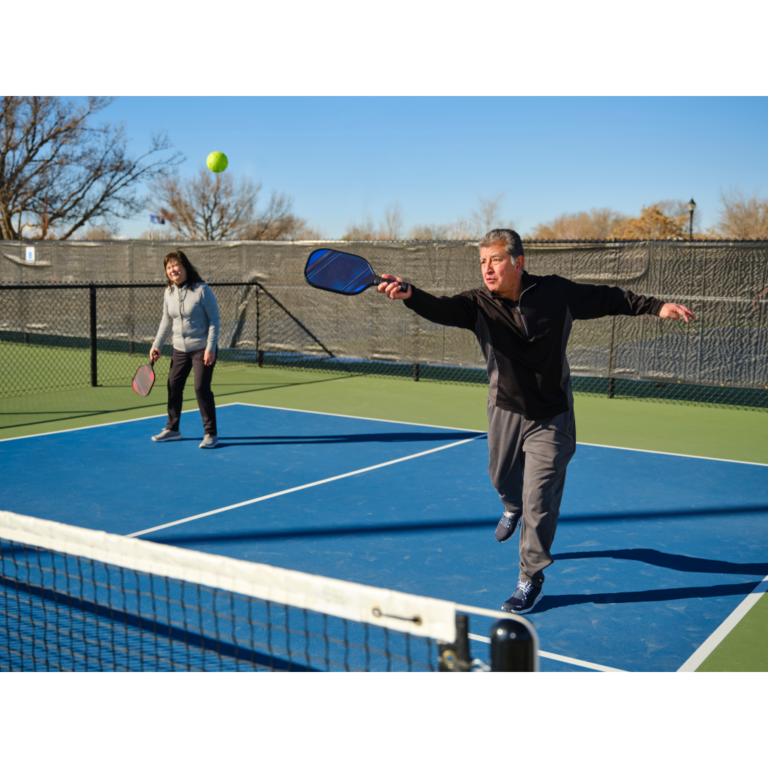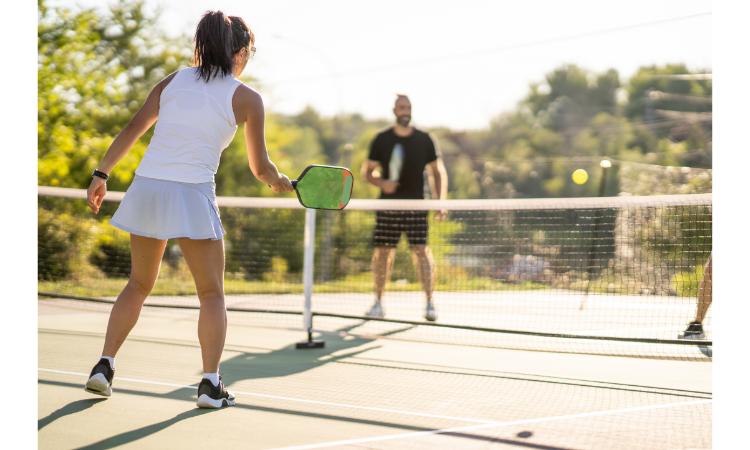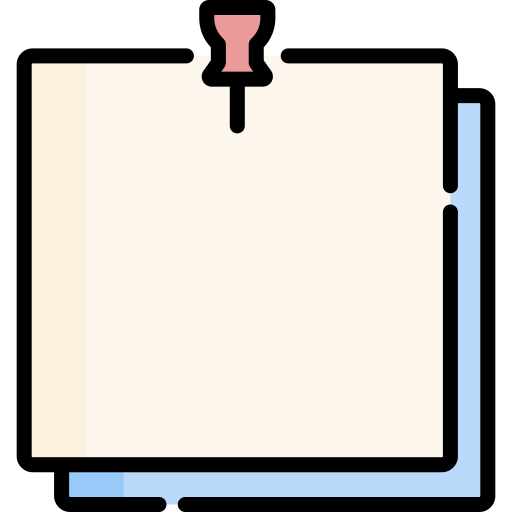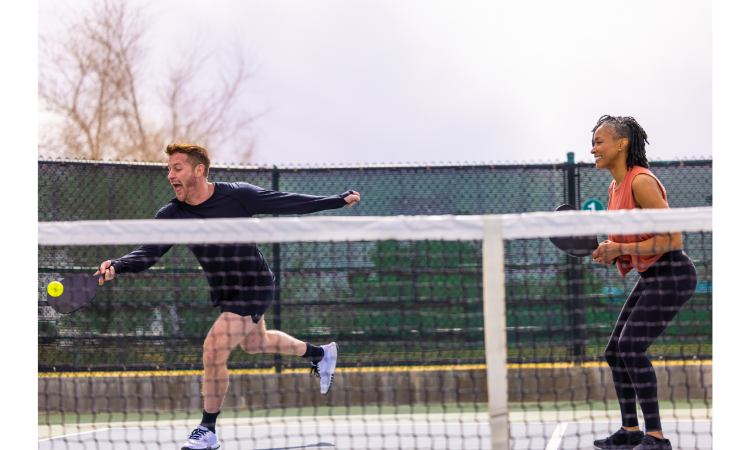There are many types of pickleball volleys that you can hit during a game to give yourself a competitive edge. From blocks and pushes to creating different spins, the volley is a crucial shot to hit when you’re implementing strategies at the kitchen line. And if you master the different volley techniques, you’ll be able to unlock winning strategies.
What Is a Pickleball Volley?
A pickleball volley is a quick, compact stroke that you hit out of the air from behind the kitchen line. Rather than letting the ball bounce to hit a groundstroke or dink, players strategically use many types of pickleball volleys to take time away from their opponent during a defensive or offensive play.
In this article, we’ll explore the different types of pickleball volleys, the pickleball volley techniques, and when to use each shot to elevate your game.
What Are the Types of Pickleball Volleys?
Different situations call for different types of pickleball volleys. For example, when you’re on the defense, you’d hit a block volley. When you’re in an offensive position, you’d hit a push volley. And sometimes, the best pickleball volley shots are hit with topspin or underspin depending on what makes your opponent uncomfortable.
Let’s dive into these types of pickleball volleys and discuss how to hit them and when to use them.
1. Forehand and Backhand Block Volley
The block volley is a shot you hit when you’re on the defensive. The goal of the block volley is to softly redirect the ball back to the kitchen to “reset” the point. Resetting the point means all four players (or two players if it’s singles) are in a neutral position, so neither team has the upper hand in the rally.
What’s the Best Pickleball Volley Technique for Blocks?
First, you need to have the correct pickleball volley grip to consistently control the block back in play. For forehand and backhand block volleys, the best grip to use is the continental grip. This grip allows you to easily connect with the ball out in front of your body with the paddle face square to the net.
Before you hit a block volley, you’ll want to be in an athletic, stationary stance so your body can absorb the power from your opponent’s aggressive shot. The goal is to keep the volley low or unattackable.
As you make contact with the ball, be sure to have a steady, firm grip to ensure the paddle doesn’t move. The steadier the paddle, the more control you’ll have. If your body pops when your paddle makes contact with the ball, the ball will also pop up.
When do you use a Forehand or Backhand Block Volley?
Block volleys are best used when your opponent speeds up the ball directly at you. Redirecting the ball back with a slower pace can throw off your opponent’s rhythm and can result in an unforced error.
I tell my students that if the flow of the rally is going too fast, take the opportunity to slow the ball down with a block volley. Controlling the pace of the rally is a great strategy to use during pickleball play because you are proactively dictating the rally while your opponents are reacting.
2. Forehand and Backhand Punch Volley
A punch volley is an offensive shot that is hit slightly faster and harder than the block volley. Unlike a block volley that requires little to no swing, a punch volley can have a slight take-back before contacting the ball and follow-through motion after contact. The elongated swing plus your forward momentum makes this shot a power pickleball volley.
What’s the Best Pickleball Technique for a Punch Volley?
Like the block volley, the best grip to use for a punch volley is the continental grip. Since the punch volley requires a firm, aggressive hit, anticipation is key because you have less time to hit the ball. Why is this? Because the best punch volleys are hit close to the kitchen line, and the closer you are to the net, the less time you have to react to a ball.
Anticipating the shot means moving your body to set up for a forehand or backhand, and starting your swinging motion before the ball travels over the net. You can anticipate a shot by keeping track of your opponent’s patterns.
For example, if your opponent attacks your backhand side 90 percent of the time, chances are when they set up for an aggressive shot, the ball will travel to the left side of your body.
When do you use a Forehand or Backhand Punch Volley?
When a ball is at chest level or higher, the best pickleball volley shot to hit is a punch volley. This is because you can hit down on the ball without hitting it in the net.
Angling the ball down toward your opponent’s feet is the best pickleball volley strategy to use when hitting a punch volley because it’s harder for your opponent to defend. And the lower your opponent’s contact point is, the higher the ball will pop up for you to attack the next shot.
Another time to use a punch volley is when your opponents have a hard time reacting to harder-pace balls. Many novice players are reactionary at the kitchen line and feel more pressure when a ball is hit fast at them. In this scenario, take more chances to speed the ball up with the punch volley. You may create more forced errors that way.
3. Forehand and Backhand Drop Volley
A forehand and backhand drop volley is a soft pickleball volley that involves a delicate touch to redirect the ball back into the kitchen. To assess if you’re hitting the ball soft enough, it should barely bounce after it lands in your opponent’s kitchen. If the ball bounces high after your shot, it means you hit the ball too hard.
What’s the Best Pickleball Technique for a Drop Volley?
Using a continental grip, contact the ball out in front of your body with a soft touch. Hold the paddle loose enough to where someone could easily take the paddle away from you, but firm enough to keep the paddle face secure on contact. The less movement you have with the paddle, the better.
When do you use a Forehand or Backhand Drop Volley?
One of the best strategies to utilize a drop shot volley in pickleball is when your opponent is at the baseline. If your opponents are far away from the net and you hit a drop volley, they have to run fast to the ball AND control it back over the net AND get back into position before you return the next shot. This requires a high athletic ability and hand control, which makes the shot hard to execute.
4. Forehand and Backhand Slice Volley
A slice volley is an out-of-the-air shot that you hit with underspin, aka backspin.
Backspin slows down the pace of the ball because you’re imparting a backward spin as you slice underneath it. Placing backspin on the ball gives you more control than a traditional pickleball volley. Backspin also creates little to no bounce when it lands on the other side of the court.
What’s the Best Pickleball Technique for a Slice Volley?
Using a continental grip, create a crescent moon shape with your paddle as you contact the ball out in front of your body. This allows you to get under the ball and create a backspin. A slice volley is typically hit cross-court because that gives you a larger area to hit into.
When do you use a Forehand or Backhand Slice Volley?
One of the best pickleball volley strategies to use when you’re in a rally at the kitchen line is to change up the spin and pace of the ball. In order to do this, try hitting a slice volley. Changing up the spin and pace makes the shots more uncomfortable for your opponent while allowing you to control the flow of the point.
5. Forehand and Backhand Topspin Volley
A topspin volley is a type of pickleball volley shot that spins forward through the court. Topspin gives you more margin for error as the ball crosses the net in a downward trajectory that keeps the ball low. Many players struggle to return a topspin volley because the ball springs up off of the bounce.
What’s the Best Pickleball Technique for a Topspin Volley?
Using an eastern or semi-western grip, drop the edge of your paddle to get underneath the ball and brush up on contact. The brush-up motion is what creates the topspin. The steeper the upward motion is on contact, the more topspin you’re able to create.
However, adding spin gives you less power, so you’ll want to create an elongated follow-through so the ball can travel over the net.
When hitting a backhand volley, use a continental grip and angle your paddle in an upward motion on contact, similar to the forehand. Think low to high as you create spin on the ball.
For both forehand and backhand topspin volleys, contact the ball out in front of your body with a slight backswing if time allows. The backswing turns a regular topspin volley into a power pickleball volley.
When Do You Use a Forehand or Backhand Topspin Volley?
Like the slice volley, a great pickleball volley strategy to use when you’re in a rally at the kitchen line is to mix in a topspin volley. Hitting a different spin creates uncomfortable situations for your opponents and could create a forced error on their part.
Advanced Pickleball Volleys
Once you’ve mastered the basic pickleball volley techniques and are ready to diversify your volleys even further, experiment with the more advanced scorpion and lob volleys. Because volleys are hit frequently at the kitchen line, it’s always advantageous to have more shot variety at the net.
1. Scorpion Volley
Never heard of a scorpion volley? That’s because it’s fairly new. Pickleball continues to evolve, with players constantly experimenting and creating new shots. Collin Johns, the number one ranked men’s pro player, is known for executing the scorpion volley with perfection.
A scorpion volley is hit on the forehand side only and is known as one of the power pickleball volleys. This shot was developed to counterattack a shot that is hit at the right shoulder of the body (also known as a chicken wing shot). Think of the scorpion volley as a mini overhead.
What’s the Best Pickleball Technique for a Scorpion Volley?
Using a continental or eastern grip (whichever feels best for you), crouch low with your paddle above your head as the ball crosses to your side of the court. Contact the ball slightly out in front and hit in a downward motion, aiming at your opponent’s feet.
When Do You Use a Scorpion Volley?
The best time to use a scorpion volley is when your opponent is continually attacking your right inside shoulder at the kitchen line. You can only execute this shot when the ball is above the shoulders. This is why it’s key to get as low to the ground as possible while maintaining your balance.
If you can master the scorpion volley, you can turn what is considered a defensive shot (hitting a chicken-wing forehand volley), into an offensive shot.
2. Lob Volley
Lob volleys in pickleball are becoming more common because, when executed correctly, they force your opponents into a defensive position. Although advantageous, the lob volley is an advanced pickleball volley that is difficult to master because it requires precision, touch, and court awareness.
What’s the Best Pickleball Technique for A Lob Volley?
Using a continental grip, angle the paddle face up as you contact the ball out in front of your body. Use your shoulder and legs to lift the ball upward as you aim over your opponent’s head, preferably on the left side of their body. The trajectory of the paddle goes from low to high at a slight forward angle to send the ball to the back of the court.
When Do You Use a Lob Volley?
The best time to use a lob volley is when you see your opponent leaning forward at the kitchen line. Many players will lean forward to anticipate hitting the next shot, especially if you’ve hit a few dink shots in a row at the same person.
One pickleball volley strategy to use is the 3:1 play. In the 3:1 play, you basically hit three dinks or volleys crosscourt to your opponent at the kitchen line, then hit a lob volley on the fourth ball. This play can catch your opponent off-guard because they’d be expecting to counter another dink or volley on the fourth shot.
Two Pickleball Volley Drills That Will Improve Your Game
Now that you know the types of pickleball volleys, it’s time to master them. One of the best ways to practice your shots is to drill them with a ball machine or with a partner. Here are two drills you can implement into your pickleball practice session.
1. One Up, One Back Pickleball Volley Drill
For this drill, grab a partner and a ball. One person starts at the baseline while the other starts at the kitchen line. Both players are either on the left side or the right side of the court hitting down the line at each other.
The person at the kitchen line feeds the ball to the person at the baseline. The role of the baseline player is to hit hard groundstrokes at the other player. The player at the kitchen line’s role is to volley back to the baseline player using a variety of volley shots: topspin, slice, and punch.
This pickleball volley drill is beneficial for multiple reasons:
-
Gaining Muscle Memory Through Volley Repetition
The player at the kitchen line drills their pickleball volley techniques, including the topspin volley, the slice volley, and the punch volley.
-
Making Contact Out In Front for Every Volley Shot
The contact point is crucial for volley success at the kitchen line. When you practice hitting the ball out in front, it reinforces when you need to swing in order to make contact with the ball. You gain confidence in volleying back aggressive shots.
-
Switching Grips Based on Volley Selection
Not all volleys are hit with the same grip (ie. a punch volley is hit with a continental grip while a forehand topspin volley is hit with an eastern grip). Making good split-second decisions on what volley to hit while switching to the correct grip is key to success in a real game.
-
Getting Your Body in the Correct Position
To hit a forehand or not hit a forehand, that is the question. But seriously, deciding to hit either a forehand or backhand volley will dictate which way you move your body. You want to make your contact out in front, but also get your body into a comfortable position to do so.
2. Cross-Court to Cross-Court Pickleball Volley Drill
Grab a partner and position yourselves on the forehand side of the kitchen line. One person feeds the ball in the kitchen to initiate a dink rally cross-court. During the rally, each player works on finding opportunities to volley the ball out of the air, directing it back cross-court.
While doing the drill, focus on hitting different types of pickleball volleys including topspin and slice volleys. For a more advanced drill, have one person speed up the ball as often as possible while the other player works on drop volleys and block volleys that land in the kitchen.
Continue this drill on the backhand side, or left side, of the court. This drill not only helps with power pickleball volleys and soft pickleball volleys but also improves your cross-court pickleball volleys.
Concluding Comments
Mastering the different types of pickleball volleys takes time, a lot of drilling, and great decision-making during gameplay. Don’t try to master them all at once. Pick one or two volleys and get really good at them before moving on to learning a different volley. Over time, you will see your game skyrocket. Happy volleying!





































